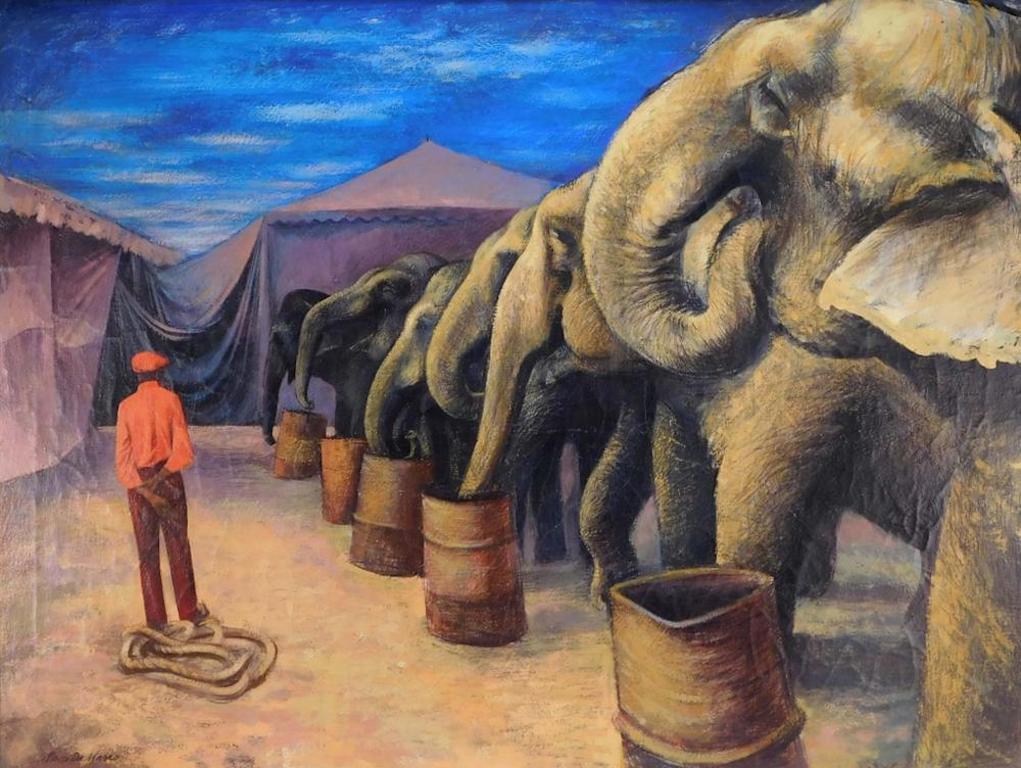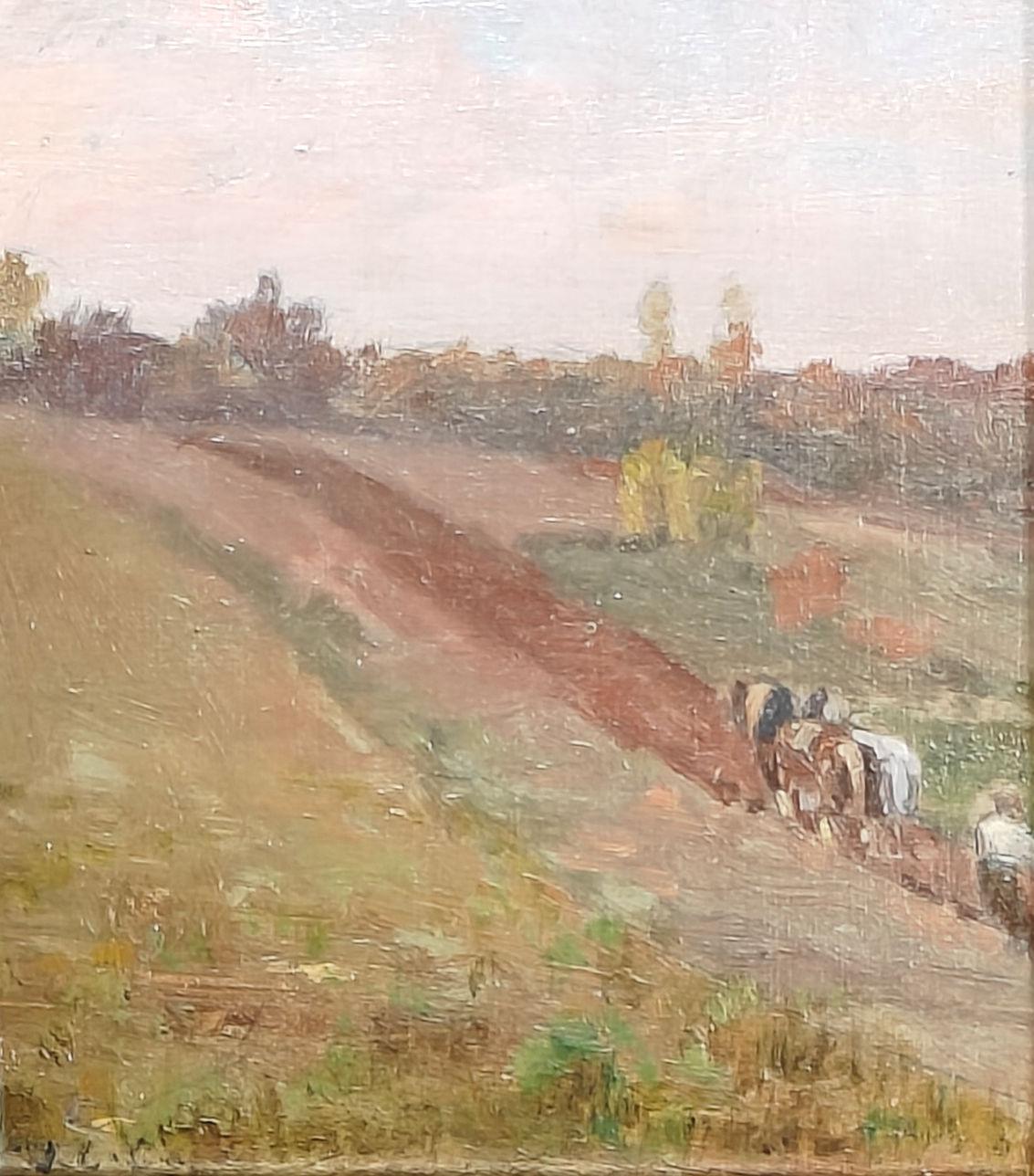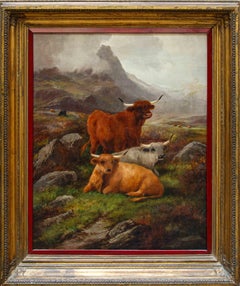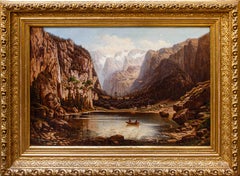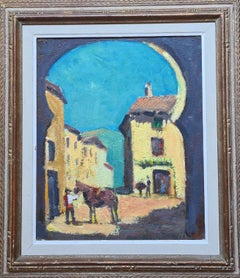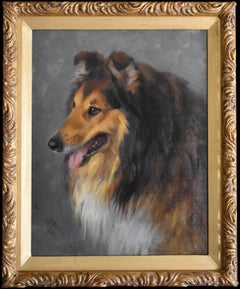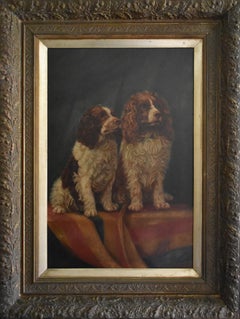Items Similar to By Emil Volkers, Pair of Horses
Want more images or videos?
Request additional images or videos from the seller
1 of 20
Emil VolkersBy Emil Volkers, Pair of Horses19th Century
19th Century
$4,757.24
£3,539.88
€4,000
CA$6,536.19
A$7,294.95
CHF 3,837.98
MX$88,613.48
NOK 48,655.31
SEK 45,535.28
DKK 30,450.47
About the Item
Emil Volkers (Birkenfeld, 1831 - Dusseldorf, 1905), attr.
Pair of Horses
(2) Oil on canvas, 25x36 cm
Framed, 42x50 cm
In the vast panorama of 19th-century German art, where the focus was divided between romantic landscapes, bourgeois portraits, and historical scenes, the figure of Emil Volkers (1831-1905) emerged. Volkers carved out a distinctive and highly valued niche for himself, becoming the painter par excellence of the horse and, by extension, of Prussian military life of his time. His works are not only testimonies of exceptional technical skill, but also valuable visual documents of an era and culture in which the horse still played a central role, both in agriculture and, above all, in the military. Born Feb. 16, 1831, in Birkenfeld, near Bremen, Emil Volkers showed a marked inclination for art from a young age. His artistic training began with preliminary studies in his hometown and then continued, as was customary for many young German talents of the time, at the Düsseldorf Art Academy. Here, under the guidance of esteemed masters, he refined his skills in drawing and painting, but it was his innate passion for animals, particularly horses, that directed him toward the specialization that would make him famous. What sets Volkers apart is his deep understanding of equine anatomy and his ability to capture the energy, grace and power of these magnificent animals. His horses are not mere details in a scene; they are the real protagonists, portrayed with a vividness and realism that reveal hours of careful observation and meticulous study. Whether they were full-speed racehorses, sturdy workhorses, or elegant parade steeds, Volkers could render their every muscle, every tension, every expression with an almost scientific precision yet imbued with life. This specialization naturally led him to paint a large number of military scenes, particularly those related to the Prussian army. The era in which Volkers lived was a time of great change and conflict for Germany, culminating in unification under Prussian leadership. The army was a fundamental component of society and politics, and horses were indispensable for cavalry, artillery, and transportation. Volkers became the visual chronicler of this reality. His canvases often depict military maneuvers, cavalry charges, field scenes, parades and equestrian portraits of officers. He did not merely render the mere action; his works are rich in details that tell the story of the soldier's life on horseback, equipment, uniforms, and surroundings. His ability to set scenes in realistic landscapes, often with dramatic skies or distinctive lighting effects, added depth and atmosphere to his compositions. In addition to military scenes, Volkers also painted numerous portraits of specific horses, often commissioned by stable owners, breeders or aristocrats who wished to immortalize their prized animals. These works are a tribute to the beauty and majesty of the horse, and show his mastery in rendering the different breeds and individual equine personalities. Volkers' fame spread quickly, and his works were in high demand by both private collectors and military institutions. His style was characterized by precise but vibrant brushwork, a rich palette, and great attention to light and shadow, which gave his canvases an impression of three-dimensionality and dynamism. Emil Volkers died on April 29, 1905 in Düsseldorf, leaving behind a significant artistic legacy. His works are not only a pleasure for lovers of horses and painting, but also valuable historical sources for anyone who wants to understand military culture and daily life in 19th-century Germany. Through his canvases, Volkers not only celebrated the power and beauty of the horse, but elevated its figure to a symbol of an entire era, making it a true protagonist of history and art.
This pair of paintings fully denotes the absolute technical expertise of the German painter, who, throughout his production, shows references to his academic training. What emerges is the absolute importance given to the figure of the horse, which, from a simple animal, is transformed into an absolute symbol of an era.
- Creator:Emil Volkers (1831 - 1905, German)
- Creation Year:19th Century
- Dimensions:Height: 9.85 in (25 cm)Width: 14.18 in (36 cm)
- More Editions & Sizes:25x36 cmPrice: $4,757
- Medium:
- Period:
- Condition:
- Gallery Location:Milan, IT
- Reference Number:1stDibs: LU2639216748192
About the Seller
No Reviews Yet
Vetted Professional Seller
Every seller passes strict standards for authenticity and reliability
1stDibs seller since 2023
Typical response time: <1 hour
- ShippingRetrieving quote...Shipping from: Milan, Italy
- Return Policy
Authenticity Guarantee
In the unlikely event there’s an issue with an item’s authenticity, contact us within 1 year for a full refund. DetailsMoney-Back Guarantee
If your item is not as described, is damaged in transit, or does not arrive, contact us within 7 days for a full refund. Details24-Hour Cancellation
You have a 24-hour grace period in which to reconsider your purchase, with no questions asked.Vetted Professional Sellers
Our world-class sellers must adhere to strict standards for service and quality, maintaining the integrity of our listings.Price-Match Guarantee
If you find that a seller listed the same item for a lower price elsewhere, we’ll match it.Trusted Global Delivery
Our best-in-class carrier network provides specialized shipping options worldwide, including custom delivery.More From This Seller
View AllLiving Natures of Animals Pseudo Vitali ( First half of the 18th century)
Located in Milan, IT
Pseudo-Vitali (Active in Bologna in the first half of the 18th century)
Pairs of Nature Vive with chickens, sheep, wicker basket
Oil on canvas, 80 x 170 cm
Framed, 95 x 185 cm
Cr...
Category
18th Century Animal Paintings
Materials
Canvas, Oil
Cows to pasture by John W. Morris
Located in Milan, IT
John W. Morris (United Kingdom, 1865-1924)
Cows to pasture
Oil on canvas, 91 x 69 cm
John William Morris is a British artist best known for his landscape paintings and animal scen...
Category
19th Century Animal Paintings
Materials
Canvas, Oil
Johann Jungblut (1860 - 1912), Lake in the Alps
By Johann Jungblut
Located in Milan, IT
Johann Jungblut (1860 - 1912)
Lake in the Alps
Oil on canvas, 64 x 93 cm
Framed, 94 x 121 cm
Signed lower right
Category
19th Century Other Art Style Landscape Paintings
Materials
Canvas, Oil
Giuseppe Bossi (Busto Arsizio 1777- Milan 1815), Portrait of a young girl
Located in Milan, IT
Giuseppe Bossi (Busto Arsizio 1777- Milan 1815)
Portrait of a young girl
Oil on canvas, 72 x 58 cm
Framed 98 x 84.5
Signed at lower right:" Gio. Bossi."
Thanks to the signature ...
Category
19th Century Other Art Style Portrait Paintings
Materials
Canvas, Oil
Paolo Monaldi (Rome, 1710 - after 1779), attr. , Genre scene
Located in Milan, IT
Paolo Monaldi (Rome, 1710 - after 1779), attr.
Genre scene
Oil on canvas, 28 x 38 cm
Framed, 36.5 x 46 cm
The canvas depicts a moment of repose drawn from the rural world: the...
Category
18th Century and Earlier Other Art Style Figurative Paintings
Materials
Canvas, Oil
Ferdinando Brambilla (Milan, 1838-1921), The Nun of Monza
Located in Milan, IT
Ferdinando Brambilla (Milan, 1838-1921)
The nun of Monza
Oil on canvas, 60.5x49 cm
Signed and dated lower right "Brambilla 1868"
The painting depicts a nun caught in the intimate...
Category
19th Century Other Art Style Figurative Paintings
Materials
Canvas, Oil
You May Also Like
French Mid-Century Oil on Canvas. 'Arco de Zocodover' in Toledo, Spain.
Located in Cotignac, FR
Mid Century oil on canvas view of the Moorish arch in the Plaza de Zocodover in Toledo, Spain by Louis Léo Hourdille. The painting is signed and titled to the back of the canvas.
Ho...
Category
Mid-20th Century Impressionist Landscape Paintings
Materials
Oil, Canvas
An Alsatian hoping for a walk
Located in London, GB
Nancy Jane Burton, G.S.L.A. (Scottish, 1891-1972)
An Alsatian hoping for a walk
signed and dated 'N.J. Burton - 1925 -' (lower right)
oil on canvas
14 x 18 in. (35.5 x 45.8 cm.)
fram...
Category
Early 20th Century Realist Animal Paintings
Materials
Canvas, Oil
A rough collie
Located in London, GB
A charming and sensitively rendered late 19th-century oil portrait of a Rough Collie, this work captures the breed's intelligence and gentle temperament with remarkable clarity. Indi...
Category
Late 19th Century Realist Animal Paintings
Materials
Canvas, Oil
Two well-behaved clumber spaniels, seated on a Witney blanket
Located in London, GB
Painted with warmth and precision, this 1907 portrait by Oscar Brown depicts a pair of Clumber Spaniels posed atop a boldly striped Witney blanket. With their dense, feathered coats ...
Category
Early 1900s Realist Animal Paintings
Materials
Canvas, Oil
Watermelon 05. Figurative, Fruit, Colorful Pop art Still life, Polish art
By Rafał Gadowski
Located in Warsaw, PL
Contemporary figurative oil on canvas painting by Polish artist Rafal Gadowski. Painting in pop art style depicting a watermelon. Colors are saturated and vibrant. Title of this pain...
Category
2010s Other Art Style Figurative Paintings
Materials
Canvas, Oil
$1,522 Sale Price
20% Off
Tense (pet dog, bulldog, baseball, animal portrait art, surrealist oil painting)
By Rudolf Kosow
Located in Quebec, Quebec
"Tense," a thought-provoking piece by Rudolf Kosow, presents a surreal interplay between a colossal bulldog and a diminutive baseball player. The dog's face, detailed with astonishing realism, conveys a palpable intensity through its piercing gaze. The size disparity between the dog and the player underscores a narrative ripe with anticipation.
The baseball player, clad in traditional attire, stands with bat at the ready, embodying a moment of concentration and readiness. This portrayal of the player, so starkly contrasted against the vastness of the bulldog's features, evokes a feeling of an undercurrent of suspense, as if the outcome of this encounter balances on a knife-edge.
Through "Tense," Kosow delves into the theme of confrontation and the moments that precede action. The artwork captures the stillness before the storm, the quiet before the play, offering a metaphor for life's high-pressure situations where individuals face larger-than-life challenges.
The painting invites reflection on the psychological interplay between fear and courage, the small against the mighty, and the personal tenacity required to stand firm in the face of overwhelming odds. "Tense" is not just a snapshot of a surreal encounter but a broader commentary on the emotional landscapes we navigate when confronted with formidable obstacles.
keywords; painting on canvas, surrealist painting, animal vs human, americana, nature, man, man vs nature, surrealism, giant animal...
Category
2010s Surrealist Animal Paintings
Materials
Canvas, Oil
